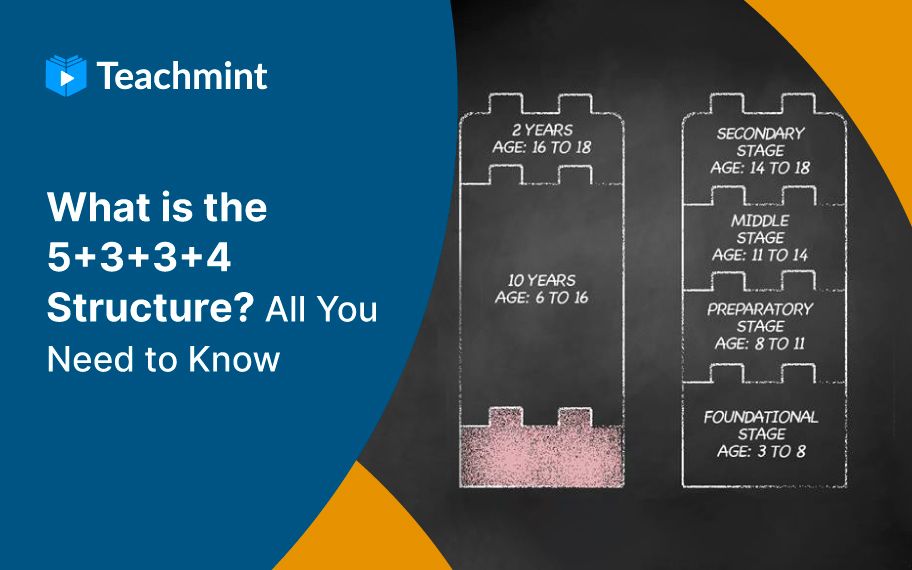One of the significant components of the New Education Policy 2020 (NEP 2020) is the replacement of the traditional 10+2 system with the 5+3+3+4 education system. The strategy attempts to provide an inclusive basis for secondary education by abandoning the 10 plus 2 years framework, which is oriented to a restrictive way of teaching. Through the implementation of the 5+3+3+4 education system It will be possible to prepare the students of today for the future, and increase their employment opportunities. So, what does the National Education Policy 5+3+3+4 education system entail, and how will it affect the field of education in India?
What is the 5+3+3+4 Education System?
Under this new education system, there are no additional school years. The number of years a child spends in a school system remains unchanged. The New Education Policy 2020 5+3+3+4 education system combines nursery and kindergarten classes with classes 1 and 2 and brings playschools within the domain of "formal education". The approach aims to conceal the distinctions between curricular and extracurricular activities as well as professional and academic interests.
Implementation of the 5+3+3+4 education system will help in structuring the education system. it will be possible to improve the schooling course by providing better accessibility to the school administration. At the same time implementing the 5+3+3+4 education system will also make it possible to enhance the accessibility towards admission, managing everyday responsibilities and maintaining quality education.
Through the help of a 5+3+3+4 education system, it will be possible To create a central system that will be connected and can deliver top quality education. At the same time it will also make sure that the right to education act is properly Incorporated for better results.
The 5+3+3+4 education system explains how to structure the entire schooling period to increase access, accessibility, responsibility, and universalization at the Early Childhood Care and Education (ECCE) or preschool level while also delivering higher-quality education because it also extends the application of the Right to Education Act to include those aged 3 to 18.
In line with the existing urban education system, kids first enroll in playschools, then move on to schools where they finish two years of kindergarten classes (KG classes), and then go to school for 12 years. This change from the 10+2 to the 5+3+3+4 education system would enable a more consistent and accessible transition from preschool to higher education (9 to 12).
An important aspect of the 5+3+3+4 education system is that it takes into consideration the changing education landscape. Considering the fact that the future comprises an education landscape that puts special emphasis on both cognitive and critical thinking abilities of the students, they need to be better prepared for that future.
Using this system, it will also be possible to help emotional and social skills along with helping the students understand the need for building ethical abilities. The system has been structured in such an efficient manner that it will not only be possible to strengthen the foundation of the students but also prepare them for the secondary education stage.
Through the implementation of the system it will also be possible to better prepare the students for college education.The reforms presented through this structure have a lot of advantages for the future as it puts an important emphasis on early childhood care and education. At the same time, it has also considered the importance of providing practical knowledge and experience to the students and provide them with better understanding of the current work structure.
The implementation of this policy is a step towards a bright future for the Indian education sector. it will allow the Students of today to carve for themselves a bright future tomorrow.
Explanation of 5+3+3+4 Education System
Here is a comprehensive explanation for each class and age group.
- According to the New Education Policy 2020 5+3+3+4 education system, students will spend 5 years in the foundational stage, 3 years in the preparatory stage, 3 years in the middle stage, and 4 years in the secondary stage.
- The phases are distinguished based on the stages of cognitive development that a child experiences in early childhood, school, and secondary school.
The following is a breakdown of the various stages of the new and reformed New Education Policy 2020 5+3+3+4 education system:
1. Foundational Stage for 5 Years:
- This stage includes students between the ages of 3 and 8.
- Preschool, Anganwadi, Class 1, Class 2, and Class 3 are included in this stage.
- According to NEP 2020, three years of preschool or Anganwadi education would be followed by two years of primary school (classes 1 and 2).
- The emphasis in this phase will be laid on play-based or activity-based learning strategies and language development.
2. Preparatory Stage for 3 Years:
- This stage includes children between the ages of 8 and 11.
- In this stage, classes ranging from third to fifth grades are included.
- Play, discovery, activity-based, interactive learning, and a child's cognitive development are all part of this stage. Language and math competencies continue to be emphasized.
- Three languages will be taught to children, with the state having the authority to choose which three.
- The regional language will be the primary teaching medium until the fifth grade.
3. Middle Stage for 3 Years:
- This stage includes students between the ages of 11 and 14.
- This stage includes the classes from 6th to 8th grade.
- Here, the pedagogical model changes to a flexible type of education.
- In contrast to the rote learning techniques that have long been employed in our educational system, the NEP 2020’s 5+3+3+4 structure states that this school instruction level will strongly emphasize critical learning objectives.
- Children will learn the fundamentals of physics, social science, mathematics, arts, and humanities.
4. Secondary Stage for 4 Years:
- This stage includes students between the ages of 14 and 18.
- This stage includes classes from 9th to 12th.
- The policy eliminates dividing pupils into separate streams, allowing them to be in a pool with a variety of subjects (multi-stream system).
- By choosing History with Physics and Accountancy, a student can put an end to the long-standing conflict between the two streams of learning.
- Again, at this level, a strong emphasis is on critical thinking and agility in the mental process.
Benefits of 5+3+3+4 Education System
- According to the new assessment plan, students will be evaluated on their basic learning in grades 3,5, and 8 using a 360-degree progress report card.
- With the new New Education Policy 2020 5+3+3+4 structure, board exams will be simplified to measure pupils' essential competencies.
- The new initiative highlights the necessity of growth by enrolling kids between the ages of 3 and 6 in formal education.
- Both academics and practitioners agree that early childhood care and education (ECCE) is crucial in defining a child's future. As a result, the NEP 2020 5+3+3+4 structure’s proudest achievement is perhaps the inclusion of pre-primary under its scope.
- Since the new school system combines multidisciplinary education and topic choices in the middle school years, stronger career counseling services are essential to assist students in making the best decisions possible.
- Choosing favored subjects as early as middle school may lay the burden of making a professional decision on parents or teachers, who are frequently unprepared to do so.
Conclusion
The switch from the 10+2 to the New Education Policy 2020 5+3+3+4 education system offers many opportunities for students' growth and sheds light on the areas that need improvement in schools. The examination pattern has also undergone a cumulative modification. The evaluation will focus on the child's growth during the early years. In this structure, core concepts and knowledge applications will be tested on the board exams. By bringing this scientific approach to education, the education system aims to bring India up to par with the world's leading nations. Teachmint offers education infrastructure solutions and a collection of school ERP & LMS features for all stakeholders of a school to aid in the education process.
To know more about NEP, read our detailed NEP 2020 blog.




